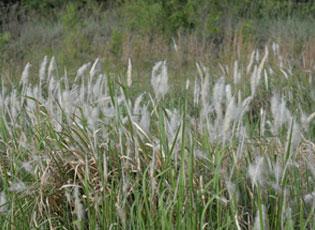Imperata cylindrica (L.) Raeusch. (ITIS)
Cogongrass, Cogon grass, Japanese bloodgrass, Red Baron grass
Imperata arundinacea, Lagurus cylindricus (ITIS)
In doubt: East Africa (Evans 1987, 1991); Southeastern Asia; (Holm et al. 1977)
First arrived accidentally in Louisiana in 1912, and it was introduced intentionally to Florida in the 1930s (Bryson and Carter 1993)
Used as packing material for imported goods (Tabor 1949); introduced intentionally as forage (Dozier et al. 1998) and for erosion control (Moorehead et al. 2007)
Forms dense stands that crowd out native species (Lippincott 1997)

Cogongrass infestation in Tift County, Georgia
Photo by Karan Rawlins; University of Georgia
Find more images
Spotlights
Distribution / Maps / Survey Status
Federally Regulated
All Resources
Selected Resources
The section below contains highly relevant resources for this species, organized by source.
Council or Task Force
Partnership
Federal Government
State and Local Government
Bryson, C.T. and R. Carter. 1993. Cogongrass, Imperata cylindrica, in the United States. Weed Technology 7:1005-1009.
Dozier, H., J.F. Gaffney, S.K. McDonald, E.R. Johnson, and D.G. Shilling. 1998. Cogongrass in the United States: history, ecology, impacts, and management. Weed Technology 737-743.
Evans, H.C. 1987. Fungal pathogens of some subtropical and tropical weeds and the possibilities for biological control. Biocontrol News and Information 8:7-30.
Evans, H.C. 1991. Biological control of tropical grassy weeds, pp. 52-72. In: F.W.G. Baker and P.J. Terry (Eds.), Tropical Grassy Weeds. Wallingford, U.K.: CAB International.
Holm, L.G., D.L. Plucknett, J.V. Pancho, and J.P. Herberger. 1977. The world’s worst weeds: Distribution and biology. Honolulu, Hawaii: University Press of Hawaii.
Integrated Taxonomic Information System. Imperata cylindrica. [Accessed Aug 26, 2023].
Lippincott, C.L. 1997. Ecological consequences of Imperata cylindrica(cogongrass) invasion in Florida sandhill. PhD dissertation, University of Florida.
Moorehead, D.J., C.T. Bargeron, and G.K. Douce. 2007. Cogongrass distribution and spread prevention [PDF, 213 KB]. In: N.J. Loewenstein and J.H. Miller (Eds.), Proceedings of the Regional Cogongrass Conference: A Cogongrass Management Guide (pp. 24-27). U.S. Forest Service.
Tabor, P. 1949. Cogongrass, Imperata cylindrica (L.) Beauv., in the southeastern United States. Agronomy Journal 41:270.
